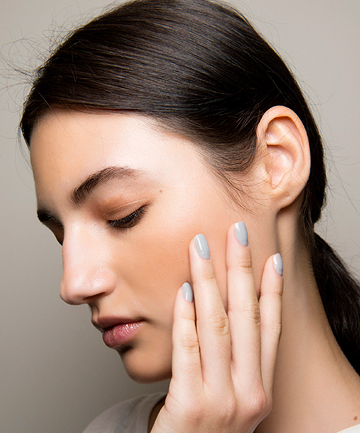Getting a pimple here and there is pretty common when you've just started with a new routine. It usually takes two to three weeks for your skin to adapt, which can lead to minor breakouts that typically clear up once your skin has adjusted.
Now, if things start getting out of hand, that's when you know you have a problem. Having two or more pimples at a time is a red flag — so you might want to stop using the product in question and switch to a new one. Try something that's non-comedogenic or has lighter water-based formula (Neutrogena Oil-Free Acne Moisturizer Pink Grapefruit, $6.69, is both!).
Image via Imaxtree
Pimples are not the only bumps you should be on the lookout for: Yep, tiny red or white bumps are definitely not part of the glass skin promise.
These pesky bumps might signify sensitive reaction to the ingredients of the products you're using. They could also be a sign that your product is too high in mineral oil content. Ditch the culprit right away and hit reset with a charcoal-based cleaning mask, such as The Body Shop Himalayan Charcoal Purifying Glow Mask, $28. Once the bumps go away, try an AHA- or BHA-based product.
Image via Imaxtree
Finding your skin to have newly uneven color is generally bad news, especially on your cheek area. This could be a sign that you're having a bad reaction to some ingredients that are meant to lighten your skin. It's called paradoxical hyperpigmentation which is related to chemicals that bleach the skin (such as hydroquinone and arbutin).
Once you notice new pigmentation popping up, be sure to abandon any product that contains these ingredients. Don't use any skin lightener until your skin color balance is restored. While you wait, coat your skin with sunscreen with at least SPF 30 (we like Kiehl's Activated Sun Protector 100% Mineral Sunscreen SPF 50, $29).
Image via Imaxtree
No, don't mistake it for having a hydrated skin: Your skin isn't supposed to be excessively oily when using a skin care product. In fact, this can even be a sign of dehydrated or overexfoliated skin. You see, strong oil-control products can dehydrate your skin, which in turn stimulates more oil production.
If this is a problem you're experiencing, try switching to products with water-boosting ingredients, such as the Innisfree Intensive Hydrating Serum With Green Tea Seed, $27. This way, you can increase water content in the epidermis while keeping your skin soft and and your sebum production in check.
Image via Imaxtree
You'll know when your skin is dehydrated when you notice fine lines, cracking and flaking. Experiencing these with your routine can mean that some of the products you are using are too harsh for your skin, which can sometimes be the case with ingredients like retinols and certain exfoliating acids. They are not necessarily bad to your skin, so you don't have to avoid them forever — but definitely try babying your skin for a while with something gentle like Simple Kind to Skin Protecting Light Moisturizer SPF 15, $9.99, if you notice your skin looking extra dry and flaky.
Image via Imaxtree









